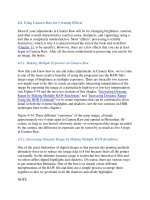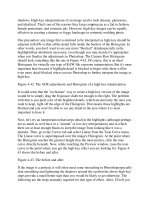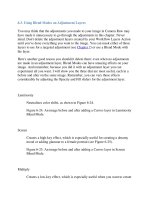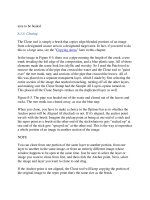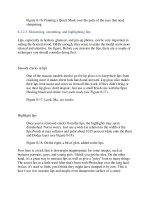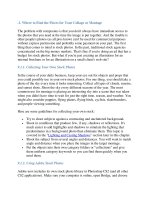Professional Information Technology-Programming Book part 39 potx
Bạn đang xem bản rút gọn của tài liệu. Xem và tải ngay bản đầy đủ của tài liệu tại đây (22.24 KB, 5 trang )
Regardless of the technique used, if the surface of what you knockout is even
slightly reflective, you will probably have some traces of the original background
color around the edges. This reflected color is easily eliminated. Choose the Brush
tool and choose Color from the Options bar's Mode menu. Go to the Layers palette
and click the Lock Transparency icon. Press Opt/Alt to momentarily convert the
Brush to an Eyedropper and click in an untinted portion of the item to pick up its
color. Now, just brush over the reflected color from the old background. When you
place the same knockout into a target image, you can do that same thing, but this
time pick up the color from the layer that will be the background image. You can
see the result of the re-coloring in Figure 9-10.
Figure 9-10. This cutout was made with the help of one of the Frames Custom
Shape tools. You could also use Layer Style to bevel the edges of shapes and to
cast shadows.
9.3.3.2. Using the Extract filter
The images that are really tough to knockout are those that are in a complex
background, have highly irregular edges (flying hair), or very soft edges (semi-
transparent or blurs). Fortunately, Photoshop 7+ comes with a tool called the
Extract filter, which improves with every new edition of Photoshop. It's not the
most sophisticated of the knockout tools, but you don't have to pay extra for it. And
most of the time, with a little practice, you can do a credible job of making the
knockout. The lady with the hula-hoop in Figure 9-11 was knocked out with the
Extract filter. Figure 9-
12 shows you the original image and the resultant knockout.
To do this:
Figure 9-11. The subject was knocked out with the Extract filter.
Figure 9-12. The Extract dialog box.
1. Open the image you want to knockout and immediately choose Image
Duplicate. There's no hot-key for this, so make yourself an Action to do this
and then assign that Action a hot-key that you're not using for anything else.
You should always duplicate any image that you're going to do very
destructive things to so that you can use the messed-up image as a layer
without destroying the original.
2. Since the Extract tool won't extract from the background layer of an image,
in the Layers palette, double-click the background layer of the duplicated
image. When the New Layer dialog appears, enter knockout and the subject
name as the name of the new layer.
3. Make sure the Knockout layer is still selected and then choose Filter
Extract. The Extract dialog shown in Figure 9-12 appears. Double-click the
Zoom tool to make the preview window show the image at full (1:1)
resolution.
4. Choose the Highlighter tool (aka the marker) and make the brush size large
enough to cover the flying hair while keeping one-third or less of the m
arker
color inside the portion of the image that should be kept. You should always
follow this one-third rule when selecting "transitional" (fuzzy or fly-away)
edges. Pan around so that you cover all those transitional edges first. Once
you've done that, make the brush size just large enough (press the square
bracket keys: [ to get a smaller brush and ] to make it larger) to cover any
slightly fuzzy edges and check the Smart Highlighting box.
5. Choose Gray Matte from the Display Menu in the Preview Options. This
will temporarily place a neutral gray background behind the preview image
so that you can more easily see what edge corrections need to be made.
6. Choose the Fill (bucket) tool and click inside the Highlighter selection. It
will fill with blue. If the blue fills the entire image, you have a space in your
Marker selection. Simply zoom in to 1:1, press the spacebar to pan, and pan
around until you find the gap(s). Then use the Marker to fill them in. Then
use the Fill tool again. Repeat until only the area inside the marker is filled
with blue.
7. Click the Preview button. You will see Figure 9-13, which clearly shows the
goofs made by the Marker selection. You can either try a new Marker
selection or use the cleanup tools. The cleanup tools are those that have a
tool in front of a Mask icon. The Brush cleanup tool erases edges with some
intelligence. Press Opt/Alt to make it replace instead of erase. The Marker
cleanup tool smooths and cleans up edges. It either does a great job or really
messes things up. If it's the latter, quickly press Cmd/Ctrl-Z to undo and use
the Brush cleanup tool.
Figure 9-13. Extract in Preview mode, so you can easily see what needs
cleaning up.
When you're cleaning up edges, it really helps to switch background colors.
Then you can se
e all the colors that need cleaning up, whereas grays may not
be visible against gray, etc.
8. Once you've finished your cleanup, click the OK button. You see the result
in the righthand image in Figure 9-11.
Third-Party Compositing Tools
There are a couple of tools that make parts of the compositing process
much easier.
The first tool, onOne Mask Pro, originally made by Extensis, was
recently acquired by onOne. Mask Pro is a third-party plug-in for
Photoshop that does quite a good job of knocking out both smooth and
fuzzy-edged images. Available for both Mac (Universal code yet to
come) and PC at a reasonable $199.95, it is quite versatile for its price. If
you've lit the background evenly enough and in such a way as to
minimize reflections, you can knockout almost anything in a totally
realistic way.
There are two main tools for designating what should be kept and what
should be thrown away: Marker and Eyedropper. The Eyedropper tool is
best used when you have a plain-colored background. You simply click
the three or four most different shades in the background and foreground.
You then use a Magic Brush tool to remove all the colors that should be
thrown out. It's an excellent tool for removing a colored background
from a portrait or a furry animal. You can see in Figure 9-14 how well it
separated the teen model's hair from the background. The beauty of this
technique is that, because you don't brush inside the object to be kept,
there's no chance of knocking out details that are the same color as the
background.
Figure 9-14. The onOne Mask Pro interface showing a portrait that is
being knocked out with the Eyedropper and Magic Brush tools.
The Marker tool works best when you have a complex background and
object that contain many colors. It's similar to the technique used in the
Extract tool. Use the Green Marker to designate the area to be deleted
and the Orange Marker to designate the area that will be kept. You then
use the Magic Bucket to click in the area that will be knocked out. As
you can see in the toolbox in Figure 9-14, there are also numerous tools
for cleanup. To find out more, go to www.ononesoftware.com.
The second tool is Ultimatte AdvantEdge, which is designed strictly for
removing matte green and matte blue (aka green screen and blue screen)
backgrounds. You have to shoot in a studio to use these backgrounds.
The other piece of bad news is the cost of this plug-in: $1,495. That's
roughly twice the price of Photoshop CS2 at full retail. Yet an amazing
number of pros buy this package. Why? Because it does a perfect or
near-perfect job of knocking out even the most complex images from
their backgrounds. Furthermore, you can do it in seconds. Pretty much
all you have to do is open the image you want to knock out in the plug-
in, click once on the background, click a button telling the program to
process, and then watch for a miracle. To find out more, go to
www.ultimatte.com.
9.3.3.3. Using the Select Color command
When you want to knockout a solid color background but you're having trouble
getting exactly what you want from the programs mentioned above, give the Select
Color command a try. It's right in Photoshop and won't cost you a penny extra
. The
main secret to getting what you want is learning how to judge the setting of the
Fuzziness slider. Find a photograph that has been taken against a reasonably solid
color background and open it in Photoshop. Then:
1. Choose Select Color Range. The Color range dialog, shown in Figure 9-
15, will appear.
Figure 9-15. You can see that the main portion of the selection is well
defined, although you'll want to use Quick Mask Mode after the selection is
made to "paint over" details inside the selection that you don't want selected.
2. Choose the method of color selection you want to use from the Select menu.
I don't have room to show you that menu here, but your choices are:
Sampled Colors; any of the primary RGB colors or their complements,
highlights, midtones, or shadows; and Out of Gamut. For making knockouts
from solid color backgrounds or taking out monotone skies, the best choice
is usually Sampled Colors.
3. Choose Quick Mask from the Selection Preview menu. You'll now be able
to see exactly what is selected when you drag the Fuzziness slider. You'll
also see the orange quick mask superimposed over your image.
4. If, in the preview window, you still see areas of color that haven't been
selected, choose the + Eyedropper and click on those colors until everything
you want is selected.
5. Drag the Fuzziness slider as far to the right as you can without letting the
Quick Mask cover any of the image that you want to knock out. The most
important thing is to get the edges right. You can always fix the Quick Mask
after the fact, as I'll show you in a second.
6.
When you have the Fuzziness and the selected colors just right, click the OK
button.
7. You'll see a selection marquee appear on your image. You will probably
want to mask some of the interior details in this selection, so click the Quick
Mask icon in the Toolbox. The orange mask will re-appear on the image.
Press D to make sure your foreground color is pure black and the
background colors is pure white.
8. Choose the Brush tool and set its Opacity at 100 percent and its Blend Mode
to Normal and paint over any interior details that aren't fully masked. If the
image you're masking is as geometric as our example, you can just make a
selection inside its boundaries the then choose Edit Fill Black. In
Figure 9-16, you can see what the fully masked image looks like in Quick
Mask mode and what the resulting knockout looks like.
Figure 9-16. Using Quick Mask mode to knock out this building.
9. Save your knockout, duplicate it, and drag the duplicate into a layer in your
composite image.




